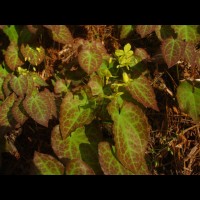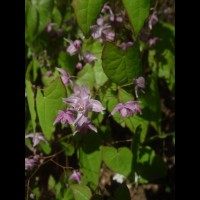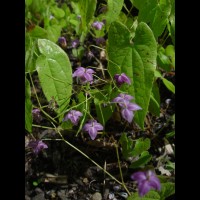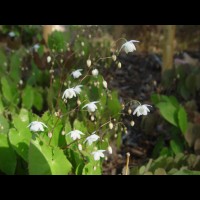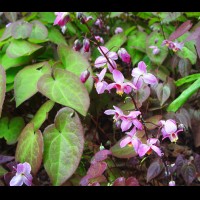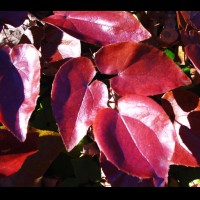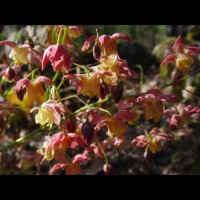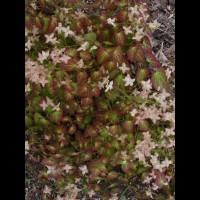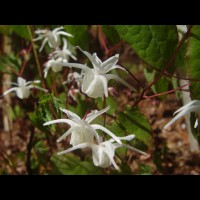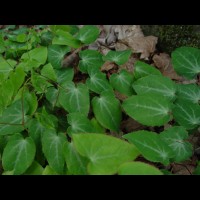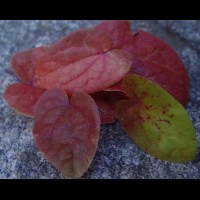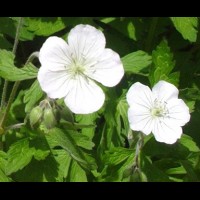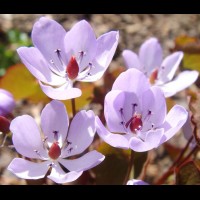Epimedium diphyllum 'Variegatum'
E. diphyllum ‘Variegatum’ (Cc. 950164)
(Synonyms: 'Shiro tiri fu', 'Shiro chiri fu')
Friends Roy Herold and the late Gerry Anderson bought this plant back from Japan for Darrell in 1995. The leaflets are variously stippled—some leaves are green with flecks of white, others white flecked green. The white variegation is enhanced with 2-3 hours of direct daily sun in our nursery. Dainty white flowers hover above leaves reminiscent of small spattered painter’s palettes. Foliage gradually turns greener through the season, but the variegation is still evident in the fall as the foliage turns to rusty red. 12" tall.
Epimedium fargesii
Epimedium fargesii (Several clones/Cc. numbers)
The typical forms of a very choice species and the main target of Darrell’s November 2000 collecting trip to China. He gathered small divisions from a variety of plants at seven locations. 12-18” tall in bloom, with narrow, medium-sized arrow-shaped, dark evergreen leaflets, that persist in the winter garden.
The medium-sized flowers typically have long, white/pale lavender inner-sepals that wrap around smaller, lavender spurs. Often both reflex backwards. Foliage exhibits dark maroon flecking in spring and sometimes fall. First flush 8-10", second growth flush to 15".
Epimedium grandiflorum 'Lavender Lady'
E. grandiflorum ‘Lavender Lady’ (Cc. 950094)
***2000 Cobblewood Introduction***
This beauty appeared as a seedling in Harold’s garden as a cross between E. sempervirens ‘Violet Queen’ and E. grandiflorum ‘Silver Queen’. Its red leaf color comes from the former and its numerous leaflets from the latter. It forms a mass of wide-spreading, low-growing leaves composed of medium-sized leaflets, their edges suffused with a deep red that fades into a soft green, netted center. This beautiful mass of foliage is topped by full panicles of large, lavender flowers with white spur tips. 8” tall in bloom. No second growth flush. Striking reddish-orange fall color. Early bloomer with a distinctly horizontal growth habit. Semi-evergreen.
Epimedium grandiflorum 'Mizuhomaru'
E. grandiflorum ‘Mizuhomaru’ (Cc. 970236)
(Synonym: ‘Sakaru Moru’)
A curious Japanese cultivar with spurs that curve sharply inward towards the cup in cold temperatures. This unique flower form makes it a popular choice when seen in bloom at our on-site nursery sales. Medium-sized, pale lavender-purple flowers. Small leaflets. 8” tall in bloom; second growth flush to 12”. Leaves sometimes turn shrimp pink in the fall.
Epimedium grandiflorum 'Mt. Kitadake Red'
E. grandiflorum ‘Mt. Kitadake Red’ (Cc. 960020)
A darling little plant, beginning its bloom with leaves only 5” tall. The large, rose-red flowers are held above the foliage at 7” high. A second flush of leaflets follows on stems to 10”. Each small leaflet is tinted with bronze to dark reddish-purple in spring. This clone has exhibited pink and yellow fall color in the nursery.
Epimedium grandiflorum 'Red Queen'
E. grandiflorum ‘Red Queen’ (Cc. 950055)
Harold Epstein bought this imposing plant in Japan many years ago, and nicknamed it “Red Queen”. As far as we can determine, it was not a named cultivar. Large, vivid, rose-red flowers peek out from under huge leaflets that may grow to 6” long/4” wide. The bold fall foliage of this regal Epimedium sometimes turns shades of pink/orange. A second growth flush of red-tinted foliage reaches to 14”. A vigorous, bold-textured choice that makes a substantial clump over time.
Epimedium grandiflorum f. flavescens #3
Epimedium grandiflorum f. flavescens #3 (Cc. 950129)
Originally sold by Siskiyou Rare Plant Nursery under the invalid name E. macranthum ‘Aureum’. At 14”, it is shorter than most other E. grandiflorum f. flavescens clones offered here. Beautiful red-copper young leaflets unfurl over large, pale yellow flowers. After bloom, large, bold, oval-shaped leaflets expand to form an impressive mound. Clear yellow fall foliage color. Spreads by 2-4" rhizomes.
Epimedium grandiflorum f. flavescens #5
E. grandiflorum f. flavescens #5 (Cc. 970232)
Reminiscent of E. koreanum ‘Harold Epstein’, with large soft yellow flowers and huge rounded leaflets, nearly as broad as long. However, its spreading rhizomes only grow 2-6” per year, forming a much thicker mass in the garden. Large, light yellow flowers held below the emerging foliage. 20” tall. Rusty red fall color.
Epimedium leptorrhizum Y44
Epimedium leptorrhizum Y44 (Same clone/Sev. Cc. num.)
From Guizhou Province in China, its large light lavender-pink flowers and medium-sized leaves are similar to those of E. brachyrrhizum-- elongated and arrow-shaped, with a corrugated texture. However, it spreads by thin rhizomes that grow 8”+ a year with foliage 6-8” tall. Forms a thick, low evergreen groundcover. Reddish fall color. Evergreen.
Epimedium macrosepalum
E. macrosepalum (Several clones/Cc. numbers)
An evergreen and drought-tolerant species from the S.E. coastal region of Russia. The flower of this species makes up for its paucity of flowers with their size. The flowers have enormous (for an Epimedium) inner sepals that are a heavenly shade of lavender-pink. Unlike most inner sepals that follow the curve of the spurs, these petaloid structures reflex back like huge rounded wings, arching above the down curving spurs, like an insect taking flight. Both the cup and the tips of the spurs fade to white. Ground hugging foliage 4-8” high is composed of small to medium-sized rounded, heart-shaped leaflets that turn deep maroon over winter. Its low, running habit makes this species a good groundcover. Vigorously spreads by thin 4-12” rhizomes.
Epimedium macrosepalum 'Sweet Rachel'
Epimedium macrosepalum ‘Sweet Rachel’ (Cc. 040102)
***2010 Cobblewood Introduction***
This beautiful, smaller foliaged form has very shiny, bright burgundy leaves in winter if grown in some sun. The ground-hugging, heart-shaped leaves have the texture of the finest leather. Same beautiful, large rose pink flowers as the species and a reliable bloomer, but with very few flowers. Spreads by thin rhizomes which grow from 4-12”a year. From a plant collecting trip Darrell sponsored in cooperation with the U.S. National Arboretum. Drought-tolerant. Evergreen.
Epimedium myrianthum
E. myrianthum (Several clones/Cc numbers)
Although the flowers of E. myrianthum are tiny, with over 100 flowers per stem, they create a billowy mass. White inner-sepals with yellow petals, and iridescent blue-black outer sepals enclosing the flowers in tight bud. Large, glossy, arrow-shaped evergreen spring leaflets are often lightly mottled with maroon. Shadows of that spring foliage mottling often reappear in the cool temperatures of fall. 18-20".
Epimedium pinnatum ssp. colchicum 'Thunderbolt'
Epimedium pinnatum ssp. colchicum ‘Thunderbolt’ (Cc. 890003)
***2000 Cobblewood Introduction***
Collected in the former USSR Province of Georgia in 1973 by Skip March of the U.S. National Arboretum. We named this clone in cooperation with the Arboretum. Cool autumn temps turn the medium-sized, semi-glossy, evergreen leaflets either dark black/purple or a rich red mahogany, depending on the light exposure. An attractive “thunderbolt” pattern of green main veins overlays the fall color. Flowers have showy bright yellow inner-sepals. 10”. Spreads by rhizomes that grow 6-8” a year making this a great groundcover. Particularly drought tolerant.
Epimedium pinnatum ssp. pinnatum
E. pinnatum ssp. pinnatum (Cc. 980084)
This eastern subspecies of E. pinnatum is uncommon in cultivation. Native to the Caspian forests of northern Iran, the late David Barker shared this with us when we visited his garden in Chelmsford, Essex, UK in 1998. Sprays of small, bright lemon-yellow flowers with tiny brown spurs erupt in early spring to 7” beyond the newly emerging foliage. While the flowers are different from ssp. colchicum in having spurs that are half the length, gardeners will notice the difference in plant habit. Generally taller with 9 medium-sized evergreen leaflets per leaf vs. 3-5. Flowers 3/4” in diameter. Leaflets are a clear spring green with a slight rose flush. Spreads by 8” rhizomes. Light red fall color. The earliest of the E. pinnatums to leaf out in spring.
Epimedium sempervirens 'Aurora'
E. sempervirens ‘Aurora’ (Cc. 920018)
Dwarf form with large, dark silky, silvery lavender blooms with glossy, small/medium-sized leaflets. 6" tall in bloom with a second flush to 9". The new growth displays occasional dark flecking in spring. Second flush may have a pink blush as the photo shows. Often has good orange-red fall color when grown in bright shade or some sun. Named by Dick Weaver and sold by We Du as a cultivar of E. grandiflorum. Semi-evergreen.
Epimedium sempervirens 'Secret Arrow'
Epimedium sempervirens ‘Secret Arrow’ (Cc. 950140)
***2000 Cobblewood Introduction***
Unique, arrow-shaped leaflets distinguish this plant. Large lavender flowers face out¬ward with wide inner-sepals. Cool fall temperatures turn the leaves a beautiful salmon-egg red, with limey green streaks along the main veins
Epimedium 'Beni Goromo'
Epimedium ‘Beni Goromo’ (Cc. 050046)
A colorful, attractive Japanese cultivar with small, medium-lavender flowers held out in clusters against bronze-maroon spring foliage. The rich flower color lightens toward the tips of the curved spurs. Antique red fall foliage color. Reaches 12”-14”.
Epimedium 'Enchantress'
Epimedium ‘Enchantress’ (Cc. 950021)
A stunning cultivar from Washfield Nursery in England, a result of Elizabeth Strangman’s cross of E. dolichostemon by E. leptorrhizum. Beautiful silvery-pink, medium-sized flowers bloom well above long, narrow, evergreen leaflets (up to 10" in height) with undulating margins. Rhizomes grow 2-4” a year. Reliable deep red fall/winter color.
E. x perralchicum 'Frohnleiten'
E. x perralchicum ‘Fröhnleiten’ (Cc. 890005)
A drought-tolerant ground cover Epimedium prized for its colorful spring foliage, a gorgeous combination of reddish-bronze over the leaflet with an intricate pattern of green veins. Small, bright yellow flowers. Spreads 4-6” a year with medium/large evergreen leaflets that remain exceptionally evergreen through our harsh New England winters. 12” tall. Blends superbly with yellow-flowered late blooming Narcissus. One of the more common varieties available in the American market, and for good reason.
Epimedium x sasakii Cc 950137
Epimedium x sasakii (Cc. 950137)
In Japan, wherever the habitats of E. sempervirens and E. x setosum overlap, hybrids occur. These highly variable hybrids were given the name E. x sasakii by Japanese botanists. However, the name is still little recognized by western botanists. All of the clones we've grown so far are semi-evergreen. 6” tall in bloom, second flush to 16”. Small, charming dark grayish-lavender flowers. In spring the leaflets are defined by a dark, thin, mascara-like maroon line at the edge of the leaf. Fall color changes to a taupe or sometimes scarlet with green veining.
Epimedium x sasakii 'Melody'
Epimedium x sasakii ‘Melody’ (Cc. 950230)
***2001 Cobblewood Introduction***
A hybrid between E. x setosum and E. sempervirens—violet, from Harold Epstein’s garden. Medium-sized, spiny, semi-evergreen leaves form a dense clump 7” tall. Lime-green new leaflets are attractively flecked with dark purple in spring. Numerous sprays of small light lavender flowers with tiny, sharply down-curving spurs appear above the foliage to 12”. The foliage often turns red with green veins in autumn. Offers a beautiful flower/foliage combination and is a distinctive addition to the garden.
E x setosum Cc 960059
E. x setosum (Cc. 960059)
A very floriferous clone from the garden of Harold Epstein. Medium-sized leaflets with prominently spined margins on plants literally covered with numerous sprays of white flowers. 8-10” tall. Semi-evergreen foliage sports a reddish fall color. A favorite of the clones we grow, but each possesses individual charm.
Epimedium x versicolor 'Cherry Tart'
Epimedium x versicolor ‘Cherry Tart’ (Cc. 970064)
***1999 Cobblewood Introduction***
A spontaneous seedling originating in the garden of Judy Springer, formerly of Great Falls, VA. Erect stems sport numerous, outfacing flowers. Large, medium-pink inner sepals back flaming, cherry-red spurs with a bright, lemon-rimmed cup. Spreads slowly by 2-4” long rhizomes. Medium-sized leaflets are handsomely flushed with reddish-purple in spring with a mustard tone that changes to a dark burgundy blush in the fall. 12-15”. Blooms early and is drought-tolerant. Semi-evergreen.
Epimedium x versicolor 'Cupreum'
Epimedium x versicolor ‘Cupreum’ (Cc. 950143)
Thanks to Carla Lankow of Renton, WA for the original stock of this captivating plant. With the same parents as ‘Versicolor’, it is similar, but has a slightly deeper flower color and more intensely red spring foliage with green venation. Usually with more numerous, slightly smaller leaflets per leaf, each more angular and less rounded. Foliage to 9” and flowers to 12”. Rhizomes grow 4-5” inches/year. Semi-evergreen with deep orange to maroon fall color. An early bloomer, it is also very drought-tolerant.
Epimedium x youngianum 'Azusa'
Epimedium x youngianum ‘Azusa’ (Cc. 950048)
Large, clean, bright white flowers have long spurs and red outer-sepals and are held aloft the foliage on thin wiry red pedicels. Medium-sized, deep green leaflets of good substance have a striking silver overlay along the main veins, extending out over the leaf and lasting the entire season. 7” tall in bloom, second flush to 12”. Early bloomer with a very crisp, tidy appearance.
Epimedium x youngianum 'Otome'
E. x youngianum ‘Otome’ (Cc. 970066)
Another gem Ozzie Johnson purchased in Japan with small, spur-less white flowers flushed pink. The first flush of flowers starts at 5” with a second flush of medium-sized, rounded leaflets and some re-bloom to 10”. Semi-evergreen with reliable red/orange fall color. A sparse bloomer, the real appeal of this clone is the beautiful fall foliage.
Geranium maculatum 'Cobblewood Ghost'
Geranium maculatum ‘Cobblewood Ghost’
This dainty woodland native bears white 1.5” blooms for 6-7 weeks in May-early June. Native to the eastern U.S. and Canada. Grows best in part shade to full sun. If planted in some sun, the dark green palmate leaves turn brilliant scarlet in fall. 2’ high by 18” wide. Darrell found this clone (far superior to the more commonly offered ‘Hazel Gallagher’) growing wild in central Massachusetts. Will naturalize in the garden from seed.
Jeffersonia dubia "Dark Centers"
Jeffersonia dubia “Dark Centers”
Name change to: Plagiorhegma dubia "Dark Centers", but I can't bring myself to call it that.
This plant provides a pop of welcome early spring color as soon as the ground thaws. New leaflets emerge a rusty brown color to contrast with the periwinkle blue/lavender petals. A cranberry colored ovary and dark purple/black anthers add to its charm. These plants are seedlings from plants Darrell collected in the wild in Korea.
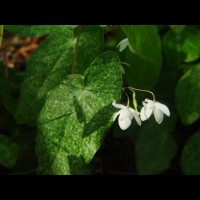
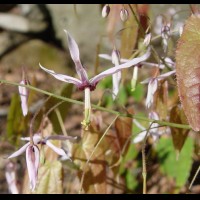
.jpg)
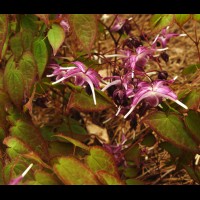
.jpg)
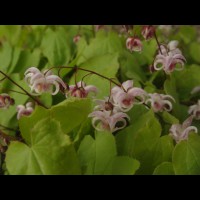
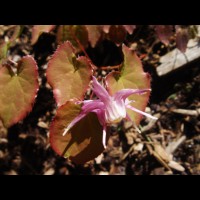
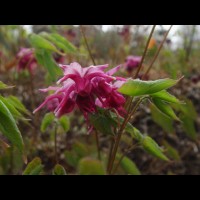
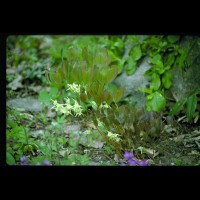
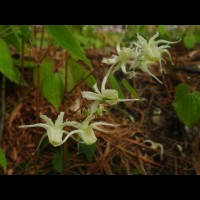
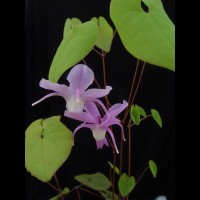
.jpg)

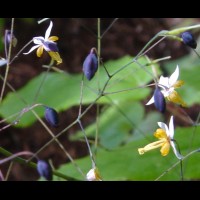
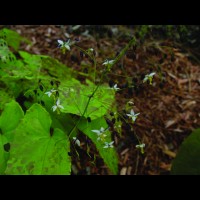
.jpg)
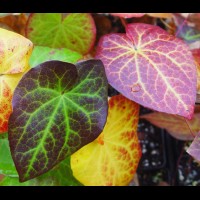
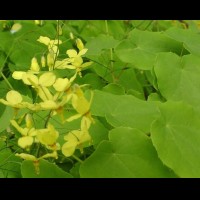
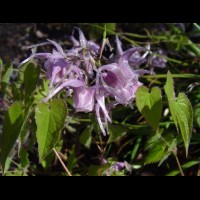
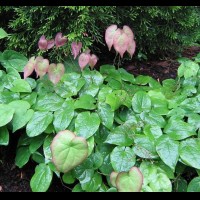
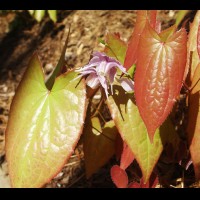

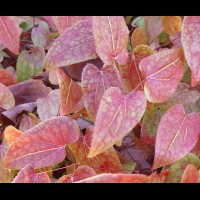
.jpg)
.jpg)
